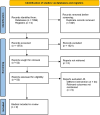Comparison of Intermittent Pneumatic Compression Pump as Adjunct to Decongestive Lymphatic Therapy against Decongestive Therapy Alone for Upper Limb Lymphedema after Breast Cancer Surgery: A Systematic Review and Meta-Analysis
- PMID: 38894955
- PMCID: PMC11182636
- DOI: 10.1159/000538940
Comparison of Intermittent Pneumatic Compression Pump as Adjunct to Decongestive Lymphatic Therapy against Decongestive Therapy Alone for Upper Limb Lymphedema after Breast Cancer Surgery: A Systematic Review and Meta-Analysis
Abstract
Background: Breast cancer is among the most prevalent malignancies in women worldwide, with substantial morbidity and mortality. Upper limb lymphedema (ULL) is a common complication after breast cancer surgery that affects patients' daily activities and quality of life. Decongestive lymphatic therapy (DLT) and intermittent pneumatic compression (IPC) therapy are 2 primary treatment methods for ULL.
Objectives: This study aimed to compare the efficacy of DLT with IPC versus DLT alone in the management of ULL following breast cancer surgery.
Method: PubMed Central, SCOPUS, EMBASE, MEDLINE, Cochrane Trial Registry, Google Scholar, and Clinicaltrials.gov databases were comprehensively searched for randomized controlled trials (RCTs) comparing DLT with IPC and DLT alone in patients with breast cancer-related ULL. The risk of bias was evaluated using the RoB 2 tool. Pooled effect sizes were calculated using random-effects models.
Results: A total of 1,894 citations were identified by the systematic search. Of them, 9 RCTs were included in the analysis. The pooled standardized mean difference (SMD) for percentage volume reduction was 0.63 (95% confidence interval [CI]: -0.24 to 1.50; I 2 = 90.9%), showing no significant difference between the DLT alone and DLT combined with IPC (p = 0.15). Pain and heaviness scores were also comparable between the groups. However, there was a significant difference in external rotation joint mobility (SMD = 0.62; 95% CI: 0.08-1.16; I 2 = 23.8%), favoring DLT with IPC.
Conclusions: Our findings suggest that DLT with IPC and DLT alone showed similar findings in managing ULL after breast cancer surgery, with DLT with IPC showing a greater impact on external rotation joint mobility. Healthcare providers should consider patient preferences and individual factors when selecting the most appropriate treatment modality for ULL management.
Keywords: Breast cancer; Intermittent pneumatic compression; Lymphedema; Manual lymphatic drainage.
© 2024 S. Karger AG, Basel.
Conflict of interest statement
The authors have no conflicts of interest to declare.
Figures





Similar articles
-
Decongestive lymphatic therapy for patients with breast carcinoma-associated lymphedema. A randomized, prospective study of a role for adjunctive intermittent pneumatic compression.Cancer. 2002 Dec 1;95(11):2260-7. doi: 10.1002/cncr.10976. Cancer. 2002. PMID: 12436430 Clinical Trial.
-
Folic acid supplementation and malaria susceptibility and severity among people taking antifolate antimalarial drugs in endemic areas.Cochrane Database Syst Rev. 2022 Feb 1;2(2022):CD014217. doi: 10.1002/14651858.CD014217. Cochrane Database Syst Rev. 2022. PMID: 36321557 Free PMC article.
-
Efficacy of intermittent pneumatic compression on breast cancer-related upper limb lymphedema: a systematic review and meta-analysis in clinical studies.Gland Surg. 2024 Aug 31;13(8):1358-1369. doi: 10.21037/gs-24-123. Epub 2024 Aug 28. Gland Surg. 2024. PMID: 39282029 Free PMC article.
-
Physical therapies in the decongestive treatment of lymphedema: A randomized, non-inferiority controlled study.Clin Rehabil. 2021 Dec;35(12):1743-1756. doi: 10.1177/02692155211032651. Epub 2021 Sep 13. Clin Rehabil. 2021. PMID: 34514891 Clinical Trial.
-
Combined intermittent pneumatic leg compression and pharmacological prophylaxis for prevention of venous thromboembolism.Cochrane Database Syst Rev. 2016 Sep 7;9(9):CD005258. doi: 10.1002/14651858.CD005258.pub3. Cochrane Database Syst Rev. 2016. Update in: Cochrane Database Syst Rev. 2022 Jan 28;1:CD005258. doi: 10.1002/14651858.CD005258.pub4. PMID: 27600864 Free PMC article. Updated. Review.
Cited by
-
Educational Review: Management of Lymphedema-Approaches, Evidence for Surgical and Nonsurgical Interventions.Ann Surg Oncol. 2025 Sep;32(9):6620-6628. doi: 10.1245/s10434-025-17463-x. Epub 2025 May 20. Ann Surg Oncol. 2025. PMID: 40392459 Free PMC article. Review.
References
-
- Lovelace DL, McDaniel LR, Golden D. Long-term effects of breast cancer surgery, treatment, and survivor care. J Midwifery Wom Health. 2019;64(6):713–24. - PubMed
Publication types
LinkOut - more resources
Full Text Sources

